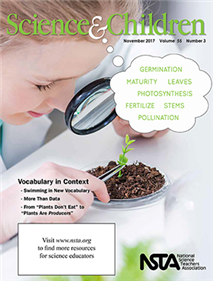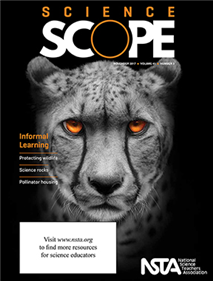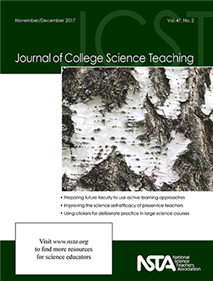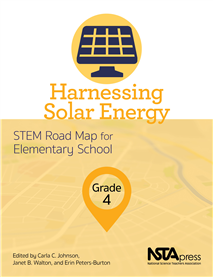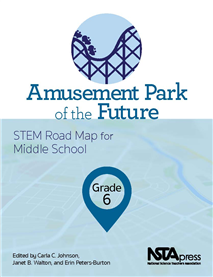All Resources
Journal Article
This column shares exercises to challenge content knowledge. This month's issue presents a new challenge and answers the Bouncing Ball challenge from last month....
Journal Article
Engineering Encounters: Chemical Reaction Vehicles
This column presents ideas and techniques to enhance your science teaching. In this issue a STEM project takes off in fifth-grade classrooms....
Journal Article
Methods and Strategies: Time to Change
This column provides ideas and techniques to enhance your science teaching. This month’s issue discusses embedding literacy into the 5E while addressing the principles of the Next Generation Science Standards....
Journal Article
Teaching Teachers: Is It Worth It? Can I Do It?
This column enhances the repertoire of preservice and inservice teachers. An interactive word wall professional development explores how to build language proficiency during a science lesson....
Journal Article
Inquiry Into Action: Ecosystems and Animals
Explore endangered animals that zoos and aquariums are working to protect....
Journal Article
Building Bee Houses: Designing and Constructing Solitary Bee Houses for Scientific Investigations
Engineer a habitat for pollinators that will increase their numbers and diversity—and answer a student-generated research question....
Journal Article
Out in the Field: Learning About Plant Diversity
Use plant-based education to teach students about the environment in which they live....
Journal Article
Teaching NGSS-Aligned Lessons in Science Classrooms
Learn to design and present three-dimensional science lessons....
Journal Article
Integrating Technology: Weather Versus Climate
This column shares how teachers use technology for assessment, student learning, or classroom management. Helping middle school students distinguish the differences during an after-school STEM career club....
Journal Article
Teacher's Toolkit: How to Start a STEM Club
This column provides how-to strategies and practical advice for the science teacher. This month’s issue describes the steps (and challenges) involved with implementing an after-school STEM career club that links hands-on activities to college majo...
Journal Article
From the Editor’s Desk: Sparking the “Need to Know”
Science Scope’s editor shares thoughts regarding the current issue....
Journal Article
Citizen Science: Where the Wildlife Are
This column highlights formal and informal science research projects that students can join and contribute to by gathering and sharing data. See wildlife and do science with eMammal....
Journal Article
Disequilibrium: Exploring Buoyancy and Density with Cartesian Divers
This column shows how to use discrepant events to confront misconceptions.In this month’s column, students design and test Cartesian divers....
Journal Article
Listserv Roundup: Technology tools for a paperless classroom
This column shares recent conversations taken from the NSTA listserv community about current science education topics.This month shares how to create a paperless classroom....
Journal Article
Science For All: Planning and Preparing Your Students With Special Needs
This column shares strategies for increasing student engagement. This issue presents a few suggestions to help your students with ADHD and autism benefit from a field trip....
Journal Article
Teacher To Teacher: Teaching With Learning Cycles and Storylines
This column provides practical advice from your peers. This issue discusses how to frame the learning cycle around a storyline....
Journal Article
Scope on the Skies: Measuring the Universe
This column focuses on astronomy throughout the year. This month’s issue discusses how to measure how far away galaxies are....
Journal Article
The study in this article examines the effectiveness of a curriculum on preservice teachers’ attitudes and knowledge of evolution and legalities of teaching it....
Journal Article
Impact of a Robert Noyce Scholarship on STEM Teacher Recruitment
Funding from the Robert Noyce Teacher Scholarship Program supports the University of Portland Noyce Scholars and Interns Program (University of Portland Noyce Program). This study examined the first 3 years of the University of Portland Noyce Progra...
Journal Article
Using Clickers for Deliberate Practice in Five Large Science Courses
Clickers are often used as an active learning tool in face-to-face classes to enhance student engagement and assess student learning. In this article the authors share the variety of ways they use clicker questions to promote deliberate practice in l...
Journal Article
Case Study: Assembling a Case Study Tool Kit: 10 Tools for Teaching With Cases
This column provides original articles on innovations in case study teaching, assessment of the method, as well as case studies with teaching notes. The author shares the strategies and tools that teachers can use to manage a case study classroom eff...
Journal Article
The authors use large-scale survey data to explore the nature, extent, and determinants of student resistance to scientific conclusions about evolution, anthropogenic climate change, and the importance of vaccination....
Journal Article
In this study, the authors incorporate feedback as a key component of a pedagogical course for future faculty who had never taught or were currently novice teaching assistants. They studied (a) how future faculty’s teaching beliefs changed over the...
Journal Article
Preservice elementary teachers need to know how to integrate the engineering design process into their science teaching. In this article, the authors describe how they used the LEGO Mindstorms EV3 Kit as part of a NGSS-aligned engineering unit in an ...
Journal Article
The increase in classroom technology has resulted in the use of clickers and other audience response systems (ARS) for simultaneous reporting of choices in the team-based learning (TBL) classroom. A variety of techniques and practices using ARS techn...
Journal Article
This article describes the impact of a hybrid Earth and space science course, taught online and complemented by a 2-hour face-to-face lab, on the science teaching self-efficacy of elementary preservice teachers over a 3-year span....
Book Chapter
Harnessing Solar Energy, Grade 4: STEM Road Map for Elementary School (Book Sample)
What if you could challenge your fourth graders to use solar energy to provide the world with clean water? With this volume in the STEM Road Map Curriculum Series, you can! Harnessing Solar Energy outlines a journey that will steer your students...
Book Chapter
Amusement Park of the Future, Grade 6: STEM Road Map for Middle School (Book Sample)
What if you could challenge your sixth graders to design an amusement park for children of tomorrow to safely enjoy? With this volume in the STEM Road Map Curriculum Series, you can! Amusement Park of the Future outlines a journey that will stee...
Journal Article
Creating Professional Development for Informal and K–12 Educators
The results of NASA’s Science Mission Directorate surveys help science education professional development providers successfully work with educators. ...
By Lindsay Bartolone
Journal Article
Editor Dennis Schatz welcomes readers to the fourth issue, which addresses the theme STEM for Early Learners. Welcome to the fourth issue, addressing the theme STEM for Early Learners. Karen Worth, expert in science, technology, engine...
By Dennis Schatz
Journal Article
The Head Start on Engineering project engages parents and children in a multicomponent family engineering program that includes professional development for teachers, workshops for parents, take-home family activity kits, home visits, classroom ext...
By Scott Pattison, Gina Svarovsky, Ivel Gontan, Pam Greenough Corrie, Marcie Benne, Shannon Weiss, Verónika Nuñez, and Smirla Ramos-Montañez
Journal Article
A Screencasting Strategy to Support STEM Learning in the Early Grades
Learn how a research–practice partnership used screencasting to promote early elementary students’ mathematics learning and communication. ...
By Josephine Louie, Pamela Buffington, and Jennifer Stiles
Journal
Connected Science Learning October-December 2017
Volume 1, Issue 4 STEM Education for Early Learners ...
Book Chapter
Scientists and Engineers Are DREAMERS (Grades 3–5)
In this lesson, students learn that scientists and engineers are dreamers. They read about amateur scientist Luke Howard in the book The Man Who Named the Clouds. After reading, they observe clouds as water-cycle components and learn how clouds help ...
Book Chapter
Scientists and Engineers Are THINKERS (Grades 3–5)
In this lesson, students learn that scientists and engineers are thinkers. They read about inventor Philo Farnsworth in the book The Boy Who Invented TV. After reading, they create a new invention or a replica of an invention from recyclables or ever...
Book Chapter
Scientists and Engineers Are INSPIRED (Grades 3–5)
In this lesson, students learn that scientists and engineers are inspired. They read about inventor Thomas Edison in the book Young Thomas Edison. After reading, they ask Thomas Edison’s three questions at four learning stations that are focused on...
Book Chapter
Scientists and Engineers Are DILIGENT (Grades 3–5)
In this lesson, students learn that scientists and engineers are diligent. They read about inventor George Washington Carver in the book A Picture Book of George Washington Carver. After reading, they will become familiar with six plant parts as they...
Book Chapter
Scientists and Engineers Are IMAGINATIVE (Grades 3–5)
In this lesson, students learn that scientists and engineers are imaginative. They read about scientist Annie Jump Cannon in the book Annie Jump Cannon, Astronomer. After reading, they learn about how Annie Jump Cannon observed variations in the brig...
Book Chapter
Scientists and Engineers Are VISIONARY (Grades 3–5)
In this lesson, students learn that scientists and engineers are visionary. They read about engineer George Washington Ferris Jr. in the book Mr. Ferris and His Wheel. After reading, they create a three-dimensional model of a Ferris wheel and learn h...
Book Chapter
Scientists and Engineers Are PATIENT (Grades 3–5)
In this lesson, students learn that scientists and engineers are patient. They read about scientist Gregor Mendel in the book Gregor Mendel: The Friar Who Grew Peas. After reading, they create a model of inherited traits in a snow-people family to un...



